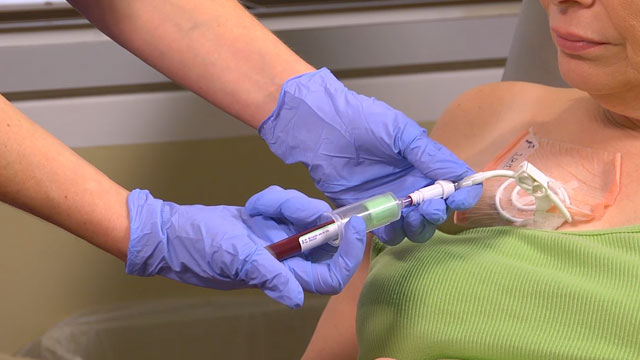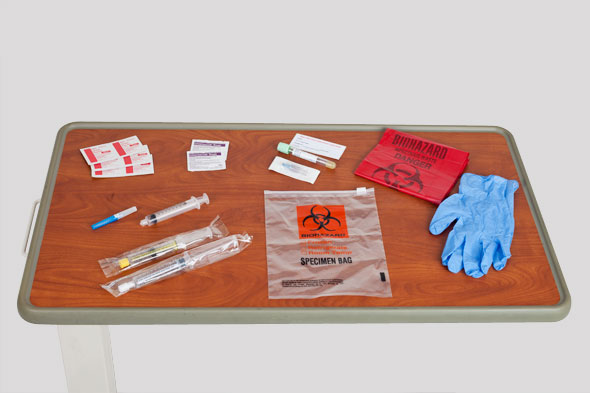Vascular Access
Select a Skill:
- » Performing Dressing Care for a Central Venous Access Device (CVAD)
- » Drawing Blood and Administering Fluid
- » Troubleshooting Vascular Access Devices
Take the Review Test:

Safety
- Observe the Six Rights of Medication Administration.
- Always use a 10-mL or larger syringe on central lines to minimize pressure during injection.
- Verify the correct catheter port for blood collection and fluid administration.
- Review the accuracy and completeness of the health care provider’s orders.
- Carefully assess the patient’s status.
- Determine if the patient is allergic to latex or chlorhexidine.
- Do not force-flush the catheter.
- Use aseptic technique throughout.
Equipment
(Roll cursor over items to see labels)

Clean gloves
Alcohol swabs
Vacutainer system
Blood tube and label
Needleless injection cap
10-mL syringe for discarded blood (1)
10-mL syringe with 5- to 10-mL saline flush (2)
10-mL syringe with 3-mL heparin flush (100 units/mL)
Specimen transport bag
Biohazard disposal
Delegation
- The skill of drawing blood and administering fluids from a CVAD may not be delegated to nursing assistive personnel (NAP). Delegation of related skills to licensed practical nurses (LPNs) varies according to each state’s Nurse Practice Act. Instruct NAP to report the following to you immediately:
- Dressing becomes damp or soiled.
- Catheter line appears to have been pulled out farther than its original insertion position.
- IV line becomes disconnected.
- Patient has a fever or other significant changes in vital signs.
- Patient complains of pain at the site.
- Review the procedure for helping with positioning the patient during blood drawing and administration of fluids if needed.
Preparation
- Review the accuracy and completeness of the health care provider’s orders for administration of IV solutions and blood sampling. Follow the Six Rights of Medication Administration.
- Assess the patient if he or she has any allergy specifically to iodine, lidocaine (Xylocaine), latex, or chlorhexidine.
- Assess the type of CVAD placed. Review the manufacturer’s instructions concerning catheter care and maintenance.
- Assess for proper functioning of an existing CVAD before therapy, including the integrity of the catheter, the ability to flush or infuse fluid, and the ability to aspirate blood.
- Assess if any catheter lumen requires flushing or if the dressing at the CVAD site needs to be changed by referring to the medical record, the nurses’ notes, agency policy, and manufacturer-recommended guidelines for use.
- Assess the patient's understanding of the CVAD and his or her knowledge of the purpose, care, and maintenance of the device.
Follow-up
- Determine daily, in consultation with the physician, the continued need for the CVAD.
- Be alert for the following:
- Shortness of breath
- Pain in the chest or shoulder
- Bleeding or swelling at the insertion site or in the neck
- Clot formation in the catheter
- Air embolism
- Infiltration/extravasation during infusions
- Catheter migration
- Erythema, warmth, tenderness, edema, or drainage at the insertion site
- Ensure continued occlusiveness of the dressing.
- Monitor intake and output, electrolyte values, and vital signs.
- Observe the catheter and its connection points, being sure they are secure and free of leaks, tears, kinks, obstructions, and cracks.
Documentation
- Immediately notify the health care provider of signs and symptoms of any complications.
- Document the catheter site when drawing blood from the catheter, including the size of the catheter, any change of injection caps, the appearance of the site, and the condition and type of securement device.
- Document any blood draws, including the date, time, and sample drawn.
- Document any unexpected outcomes, health care provider notification, interventions, and the patient’s response to treatment.
Review Questions
1. When drawing blood from a patient’s central venous access device (CVAD), what can the nurse do to minimize pressure on the device during flushing?
 Clamp the device.
Clamp the device. Use a 3-mL syringe for the flush.
Use a 3-mL syringe for the flush. Use a 10-mL syringe for the flush.
Use a 10-mL syringe for the flush. Cleanse the catheter hub with an alcohol swab.
Cleanse the catheter hub with an alcohol swab.
2. When drawing blood from a central venous access device (CVAD) in which all ports are patent, it is recommended that the nurse select which lumen?
3. Which action can the nurse take to ensure a quality blood sample when drawing blood from a patient’s central venous access device (CVAD) site?
 Allow fluid infusions to continue to flow right up to the time of the sample.
Allow fluid infusions to continue to flow right up to the time of the sample. Flush the catheter after aspirating for blood return.
Flush the catheter after aspirating for blood return. Ensure that the patient has been resting quietly for at least 15 minutes before taking the sample.
Ensure that the patient has been resting quietly for at least 15 minutes before taking the sample. Discard the first 4 to 5 mL of blood drawn.
Discard the first 4 to 5 mL of blood drawn.
4. After drawing blood from a patient’s central venous access device (CVAD), what would the nurse do to ensure that the device resumes proper functioning?
 Discard the initial 5 mL of aspirated blood.
Discard the initial 5 mL of aspirated blood. Apply an antiseptic to the injection cap.
Apply an antiseptic to the injection cap. Wear clean treatment gloves during the procedure.
Wear clean treatment gloves during the procedure. Flush the catheter with preservative-free 0.9% sodium chloride, per agency policy.
Flush the catheter with preservative-free 0.9% sodium chloride, per agency policy.
5. After drawing blood from a central venous access device (CVAD), which action would minimize the patient’s risk for infection when reconnecting prescribed intravenous fluids?
 Wearing clean gloves
Wearing clean gloves Changing the IV tubing
Changing the IV tubing  Cleansing the IV needleless connector and the end of the IV tubing with a 2% chlorhexidine swab
Cleansing the IV needleless connector and the end of the IV tubing with a 2% chlorhexidine swab Aspirating for blood return before flushing the catheter
Aspirating for blood return before flushing the catheter
You have completed the Review Questions for this skill. To take the Review again select the Start Over button. To proceed to another skill select from the dropdown menu. Select the Home or Back button to proceed to the next section.


